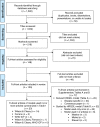Systematic review of health-related quality of life models
- PMID: 23158687
- PMCID: PMC3548743
- DOI: 10.1186/1477-7525-10-134
Systematic review of health-related quality of life models
Abstract
Background: A systematic literature review was conducted to (a) identify the most frequently used health-related quality of life (HRQOL) models and (b) critique those models.
Methods: Online search engines were queried using pre-determined inclusion and exclusion criteria. We reviewed titles, abstracts, and then full-text articles for their relevance to this review. Then the most commonly used models were identified, reviewed in tables, and critiqued using published criteria.
Results: Of 1,602 titles identified, 100 articles from 21 countries met the inclusion criteria. The most frequently used HRQOL models were: Wilson and Cleary (16%), Ferrans and colleagues (4%), or World Health Organization (WHO) (5%). Ferrans and colleagues' model was a revision of Wilson and Cleary's model and appeared to have the greatest potential to guide future HRQOL research and practice.
Conclusions: Recommendations are for researchers to use one of the three common HRQOL models unless there are compelling and clearly delineated reasons for creating new models. Disease-specific models can be derived from one of the three commonly used HRQOL models. We recommend Ferrans and colleagues' model because they added individual and environmental characteristics to the popular Wilson and Cleary model to better explain HRQOL. Using a common HRQOL model across studies will promote a coherent body of evidence that will more quickly advance the science in the area of HRQOL.
References
-
- Centers for Disease Control and Prevention (CDC. Measuring Healthy Days. Atlanta, Georgia: CDC; 2000.
-
- Healthy People. Topics and Objectives Index – Healthy People. HealthyPeople.gov; 2011. http://healthypeople.gov/2020/topicsobjectives2020/default.aspx.
-
- World Health Organization. International Classification of Functioning, disability, and Health: Children and Youth Version: ICF-CY. Geneva: World Health Organization; 2007.
-
- Walker LO, Avant KC. Strategies for theory construction in nursing. 4. New York: Prentice Hall; 2005.
Publication types
MeSH terms
LinkOut - more resources
Full Text Sources
Miscellaneous


